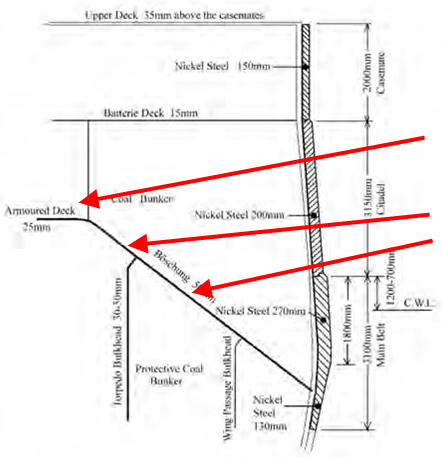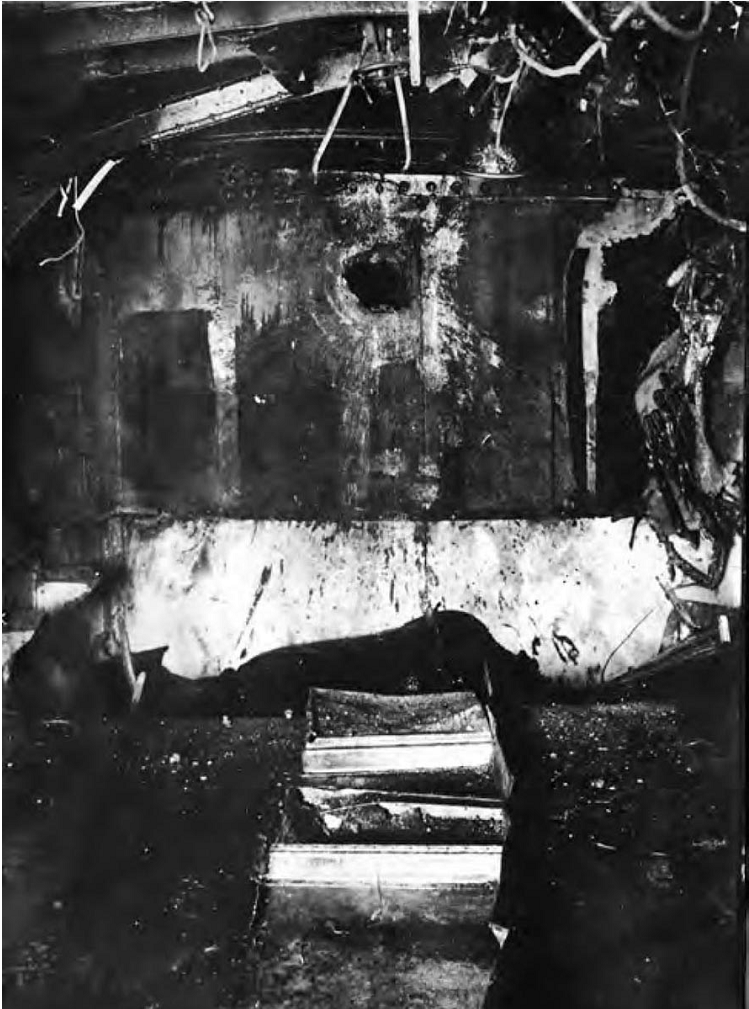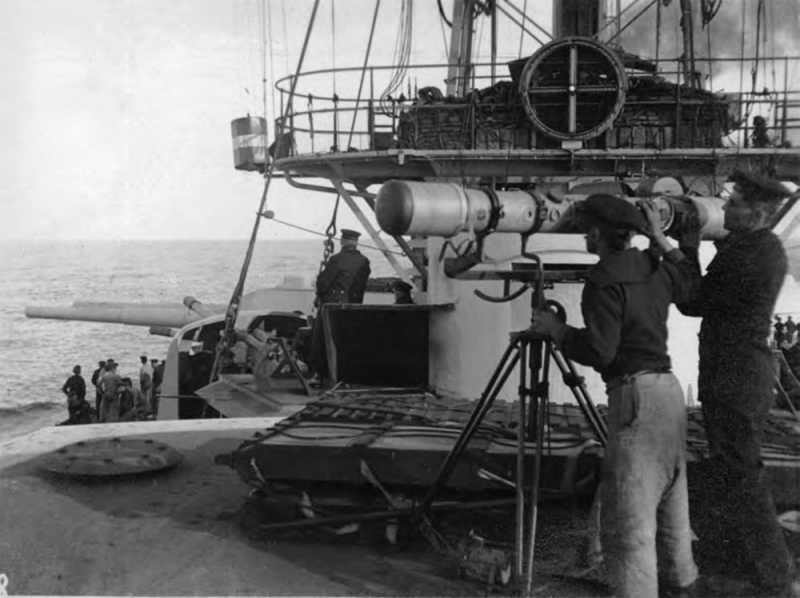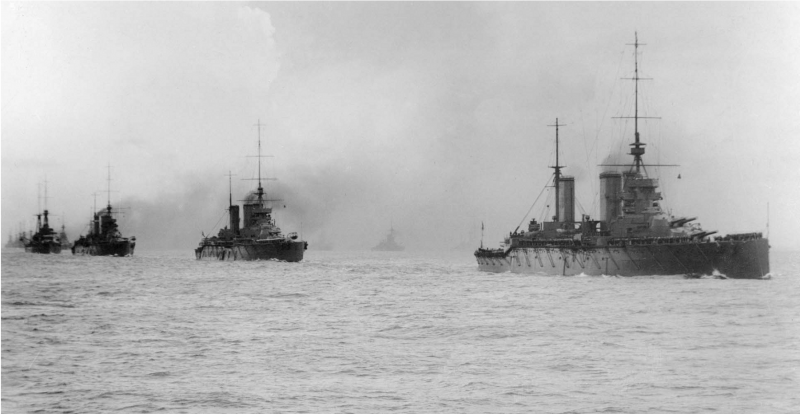Line Cruiser Rivalry: Moltke vs. Lion. H. 3
Artillery and Booking
Unfortunately, detailed data on armor penetration of 280-mm / 50 and 343-mm / 45 guns are not available to the author of this article, but nevertheless, some conclusions can be made without them. As is known, the thickest armor of the “Lion” was 229 mm thick (not including protection of the conning tower), while Moltke had the 270 mm. For 343-mm “Lion” cannons, firing a “lightweight” 567-kg projectile, indicates the ability to pierce Krupp armor 310 mm thick at 10 000 yards, or almost 50 kbt. Recalculation using the formula by Jacob de Marr suggests that the Moltke 270 mm armor belt will be broken from the 62 kbt distance. At the same time, the author could not find any calculated data on the armor penetration of Moltke guns, but, as we said earlier, according to German data, the somewhat weaker 280-mm / 45 guns of the Fon der Tanna 200 mm Krupp armor on 65 cable. The Moltke guns fired projectiles of the same caliber and weight as the Fon der Tanna cannons, but gave them a greater initial velocity on the 25 m / s. In the Battle of Jutland, Moltke punched 229 mm Tiger's armor from a 66 KB unit, so it would not be a big mistake to assume that his guns were able to penetrate 229-235 mm armor plates at a distance of 65-66 KB.
Thus, we seem to see an approximate parity of "Lion" and "Moltke" in the ability to hit your opponent. Still, the 3-4 cabling advantages of Moltke (the “invulnerability zone” in the 62-66 range of cabels, on which Moltke already pierces 229 mm Lion’s armor, and Lyon cannot hit the German Linear 270 mm yet cruisers) is too insignificant to have a real impact on the outcome of the battle. However, in fact, everything is much more complicated.
The fact is that Moltke’s 270 mm armor was defended by a very narrow (albeit long) side section at the waterline - the height of the 270 mm section of armor plates was only 1,8 m. This provided good protection against flooding and protected the artillery cellars from the penetration of them enemy shells, but above the board "Molte" defended only 200 mm armor. From the projectile that pierced the 200 mm of the armored belt, cars, boilers, and, in fact, Moltke's artillery cellars were protected only by an armored deck that had 25 mm in the horizontal part and 50 mm on the bevels. However (theoretically!), Similar protection was quite permeable for an 343-mm armor-piercing projectile on the same 62 kbt - he punched 200 mm armor, went deep into the ship and hit the deck or bevel.

And even if the kinetic energy of the projectile was not enough to overcome this obstacle, it would have exploded directly on 25 mm or 50 mm armor plate, or at the time of overcoming them. Of course, in this case, the projectile would not have gone deep into the engine or boiler rooms as a whole, but machines, boilers, etc. would still be hit by shell fragments and deck armor. In this case, the 200 mm armor British 567 kg shell pierced, in general, at all imaginable distances of the battle - up to 100 KB. Of course, this is not the test results, but only the calculation according to the de Marr formula, but the battles of the First World War fully confirm such possibilities of 343-mm guns.
So, in the battle at Dogger Bank, the Lion projectile struck an unarmored Seidlit deck from a distance of approximately 84 (which, at least slightly, but slowed it down), and then 230 mm barbet of the main caliber tower. The British projectile exploded during the passage of 230 mm armor, but at that time it was generally characteristic of British heavy artillery, in our case it is important that the Lion from a distance of 84 kbt did not just pierce the deck and 230 mm barbet, but also caused heavy damage to the space protected by the barbet - the German battleship was close to death, one hit destroyed both towers of the main caliber, and the 165 people died.

The barbety and turret of the main caliber Moltke had 200-230 mm protection and were also vulnerable. Consequently, both the machines, the boilers, and the Moltke artillery could theoretically be hit by the Lion at distances of approximately 62-85 KB. Thus, with the exception of a narrow 270 mm strip on the waterline, the Moltke's reservation did not protect the vital parts of the ship from full-fledged armor-piercing 343 mm shells. However, it should be stipulated separately that such inability of Moltke to resist the English guns arose only after the Jutland battle, towards the end of the war, when the British developed first-class armor-piercing shells, Greenboy.
The fact is that the British, having adopted an ultimatum-powerful 343-mm gun, did not bother to provide it with equally high-quality armor-piercing shells and made it only from Jutland’s experience. Until then, British ammunition of this type was extremely inclined to explode when passing armor, and this seriously changed the protection status of Moltke. After all, the projectile, which exploded in 200 mm armor, continued its flight only in the form of splinters, and such a blow 50 mm bevels and 25 mm horizontal deck could well reflect. However, for the 203-230 mm barbet and the Moltke towers it didn’t matter much - there was no protection behind them, and the passage of the projectile, at least in the form of fragments, caused the hardest damage that could threaten the ship with death.
In general, taking into account the real qualities of the British 343-mm armor-piercing shells, it can be stated that the Moltke vertical booking at the main combat distances (70-75 kbt) could with great probability protect the engine rooms, boiler rooms and ammunition cellars when hit by board, but did not provide protection for artillery towers and barbets.
However, “Lion” in the confrontation with “Moltke” also did not look like an invulnerable knight. His 229 mm belt height in 3,5 m, in combination with inch armor and 229 mm main turret towers, were probably impenetrable for German projectiles on 70 cable and beyond, but 203 mm barbety at this distance could still be struck. The main problem was the armor belt "Lion" in the area of the feed pipes of the bow and stern towers of the main caliber thinned to 102-127-152 mm. Such armor, apparently, penetrated 280-mm German shells and 75-85 KBT., And only 152 mm protection of the second tower could still count to reflect the impact.
Consequently, as in the case of the Moltke, the vertical booking of the Lion did not provide reliable protection at the main combat distances (70-75 KBT.) From the 280 mm projectiles of the German battlecruisers. Like the German battle cruiser, the engine and boiler rooms were well protected, but the artillery was not.
Thus, in terms of the thickness of the vertical armor and the armor penetration capability of the guns, we see parity (before the appearance of the Greenboy projectiles, after which the English ship received the obvious advantage), but one should not forget about such an important parameter as the armor's projectile action. And the British 567-mm shells of the British 302 kg of “suitcases”, almost twice the weight of the 280 kg, were significantly stronger. Without a doubt, the British armor-piercing projectile equipped with 18,1 kg of liddite in an explosion could cause far more damage than the German one, who had 8,95 kg of trotyl. Of course, the mass of explosives in the "greenboats" decreased (to 13,4 kg), but it still remained greater and, moreover, it was compensated by improved armor penetration. For Moltke there was only an advantage in the number of guns of the main caliber (10 versus 8), but of course, these two additional barrels could not compensate for the power of the British 343-mm projectiles.
As for the horizontal armor, here, by and large, the situation was bad for both battlecruisers. Formally, the Lion’s 25,4 mm double decks looked twice as good as Moltke’s 25,4 mm, but in practice both were not a reliable barrier for heavy projectiles. Some serious horizontal protection can only be talked about in the Moltke casemate, which (in addition to the 25-mm armored decks under it) had 25 mm "floor" and 35 mm "roof", which, together, allowed us to hopefully keep 305 -mm projectiles from penetrating the armored deck (even in the form of fragments). Lion had a similar section, next to chimneys and the third tower, - the forecastle deck was thickened there to 38,4 mm (but not from side to side). In view of the above, the horizontal protection of these ships can be considered approximately equivalent, but the problem of the German battle cruiser was the disparity of the threats - heavy and powerful 343-mm shells were much more dangerous for the Moltke decks than the relatively light Molnka X-guns for "Lion".
In addition, for both ships there was a danger of "easy" penetration of projectiles into the barbets of guns of the main caliber. The fact is that the barbet itself is a very wide pipe with a diameter of up to 8 meters and more, its weight is very large - and such barbets require 4-5, according to the number of towers of the main caliber. In order to alleviate the mass of barbets, differential booking was used - for example, opposite the side protected by 200 mm armor belts, the Molbt barbetas had only 30 mm thickness, opposite 150 mm of the upper belt - 80 mm, and where the side armor was not defended barbety - 200 mm. It was logical in the sense that in order to get to the delivery pipes, the projectile had to overcome first the onboard armor, and only then - the barbet's armor, but it was overlooked that the projectile could please the “weak” part of the barbet, punching the board, and passing through the deck.
In general, it can be stated that the Lion-class battle cruisers were significantly superior to the German Moltke type ships in terms of defensive and offensive qualities. With the advent of full-fledged 343-mm Greenboy armor-piercing projectiles, this advantage became almost overwhelming. But even in this case, the duel with Moltke remained a dangerous business for the British battle cruiser - there were enough vulnerable spots in the defense of the Lion, getting into which an 280-mm projectile could have caused very serious and even fatal consequences.
Speed and seaworthiness.
The speeds of the Moltke and Lyon turned out to be quite comparable, during the tests the ships of both types developed 27-28 knots, and in the realities of the service they were probably slightly less, but in general their driving performance can be considered approximately equal. The range of the Moltke and Goeben was slightly less - 4 miles at 230 knots versus 17 miles at 4 knots at the Lyon. The British have always attached great importance to the seaworthiness of their ships, and therefore it is not surprising that the battlecruisers of the Lyon type became high-class handsome (though ... in English, it should be said, “beauties”). At the same time, German battlecruisers (and the Moltke are no exception) are usually considered low-sided. But such an important indicator for a warship as the height of the axes of the guns relative to the surface of the sea attracts attention. It is clear that the higher the guns are located, the more difficult it is to fill them with water on a wave. With normal displacement, the axis of the Lyon guns towered above the waterline (starting from the bow, the first tower) by 935 m, 16,75 m; 10 m and 12,4 m. At Moltka, respectively, 9.4 m, 7 m (two “traverse” towers) and aft 10,4 m and 8,2 m. Thus, we can say that according to this parameter battle cruisers in Germany and England were slightly different. On the other hand, of course, the height of the trunks above the sea is far from the only parameter of seaworthiness; here, permeability to the wave is important, etc. In the royal Navy they rated the seaworthiness of “Admiral Fisher's cats” very highly, noted only a very strong roll-on, because of which these ships did not become as stable combat platforms as could be expected with their displacement. As for the Moltke, the author did not find any information about the problems with the seaworthiness of ships of this type. In addition, the German battle cruisers were built to participate in the general battle as a high-speed wing, and not for use in remote ocean theaters, and at least for their operations in the North Sea their seaworthiness was enough.
Conclusions
We used to perceive the German ships of the First World War era as excellently protected combat vehicles, and rightly so - no one in the world paid so much attention to the protection of battleships and battle cruisers, as did the German engineers and shipbuilders. They did an excellent job in the case of the Moltke, but it should be understood that it was designed (and then, with certain assumptions) to counter the 12-inch shells. The British, having switched to 343-mm caliber, radically changed the rules of the game - against such projectiles Moltke’s defense was no longer sufficient. The battle of “Moltke” against “Lion” was, in the full sense of the word, a “egg-shell armed with hammers” fight and, despite the best defense, “Moltke” in this battle had more weak spots than “Lion”. But there was still no absolute superiority of the British ship: “Moltke,” like his opponent, had the ability to deliver a fatal blow to the Lion, the German battle cruiser was less likely to have that chance.
The speed of technical progress of those years attracts attention. A first-class first has just been laid, at the time of the start of construction, the uniquely best-in-the-world battle cruiser, Fon der Tann, and after it - one per year - two ships of the Moltke type. They are an improved copy of the first battlecruiser of Germany, but if the Von der Tann was the strongest ship of its class, the Goeben was already significantly inferior to the Lion, with which they were almost the same age. In other words - the speed of progress was as follows, then the improved design of the best ship in the world was out of date for some two years!
Studying history the design of the German battlecruisers, two quite understandable, but no less regrettable errors can be distinguished. Initially, on the Moltka, the Germans intended to unify the main caliber with the corresponding dreadnoughts, i.e. type "Helgoland" and it would be quite the right decision. But during the design they abandoned eight 305-mm guns in favor of ten 280-mm - according to the tactical views of the German fleet, a ship designed for squadron battles should have been able to fire several enemy ships simultaneously, and for this 10 guns were much better suited than 8. At the same time, the use of 10 305-mm guns was a very "hard" decision (by weight) and did not allow to adequately strengthen the protection of the future ship.
However, as the history of the First World War at sea shows irrefutably, this concept was completely erroneous - at the same time, get “Moltke” instead of 10 280-mm 8 very powerful 305-mm / 50 guns if he didn’t have the same qualities, then, at least, he came close to Lion. However, the Germans decided that "and so it will come down" and left on the Moltka 280-mm gun. This was the first mistake of the German shipbuilders.
Nevertheless, the “Moltke” project should in no way be considered a failure or some kind of wrong: as we said earlier, the moment of his laying roughly coincided with the start of construction work on the British Indefatigeble, which in all respects was inferior to the newest brainchild “ gloomy Aryan genius ". In other words, laying the Moltke (even with 280-mm cannons), the Germans did not make any mistake, but the beginning of the construction of the Goben next year for the same project cannot be considered a correct step. In essence, Germany should either build the same type "Moltke" and "Goeben", but with 305-mm guns instead of 280-mm, or it was necessary to pawn the "Goeben" on a new project. They did not do this, and for some time the leadership of the battle cruisers was lost by Germany.
As for the British, they really created a revolutionary ship. The British admirals and constructors set themselves very high benchmarks: a rise in speed from 25,5 to 27 nodes, an increase in the caliber of guns from 305-mm to 343-mm and an increase in armor thickness from 152 mm to 229 mm. These qualities were completely impossible to fit into a displacement equal to the modern battleship, and the British went on an unprecedented step — linear cruisers of the Lyon type had already received a greater displacement at the design stage than their "analogs" — Orion-type battleships. Without a doubt, already at the TZ stage, the British ships were distinguished by a strong imbalance of armament and protection, but the fact of the matter is that against their German counterparts with 280-mm artillery 229-mm armor of Admiral Fisher’s cats was, in general, enough In essence, the main problem of the Lions was that the British could not protect such armor with the entire citadel and barbety of the towers of the main caliber - do it, and the British fleet would receive a series of battle cruisers for which Moltke and Goben would legal booty. Nevertheless, in the face of the "Lions", the British fleet received a series of not ideal ships, but they were fully responding to their missions.
What did the Germans answer?
Продолжение следует ...


Information